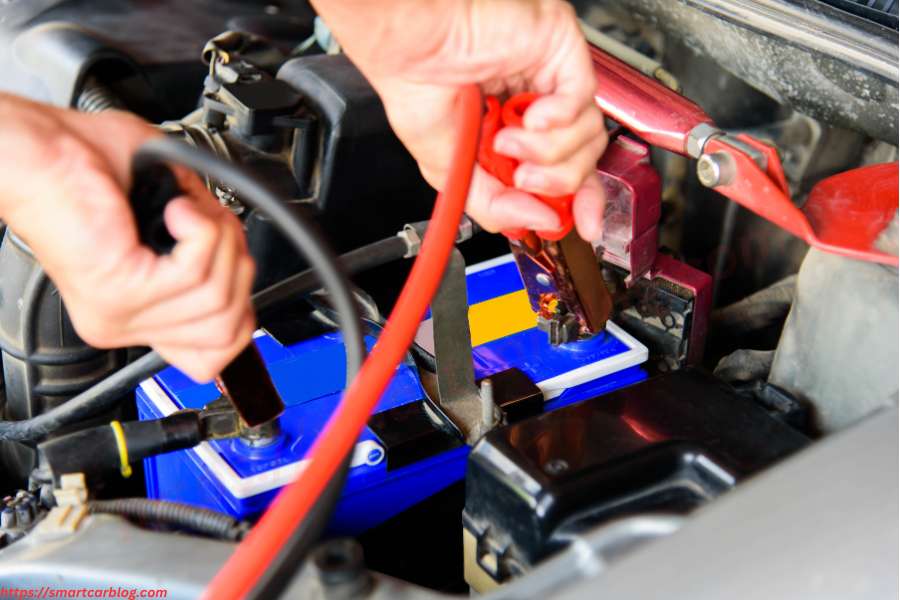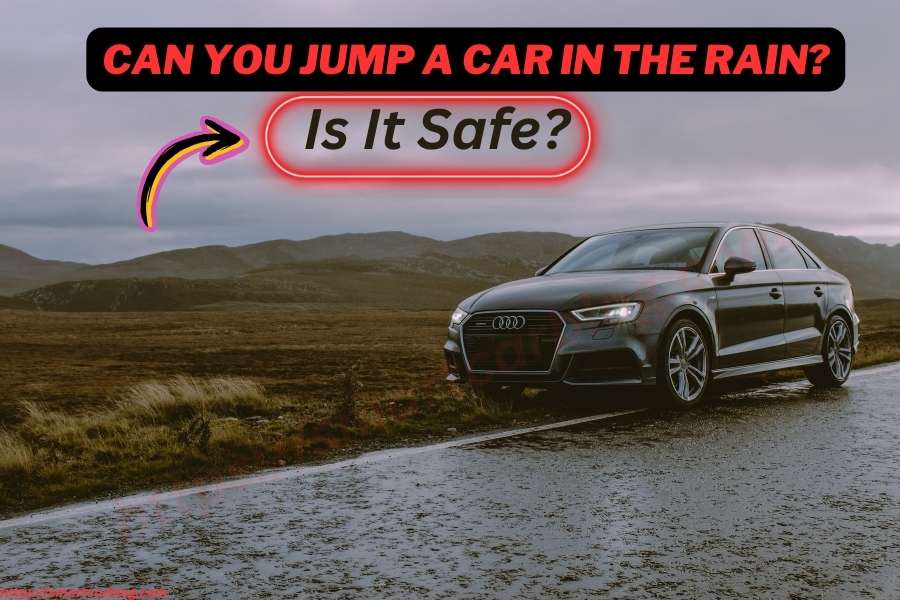“Can you Jump a Car in the Rain: A Common Dilemma for Many Drivers Facing a Dead Battery During a Downpour.”
Imagine this challenging scenario: you’re all set to drive home, but your car won’t start, and it’s raining heavily. This situation prompts an important question – is it safe to jump-start your car under such wet conditions?
This wet and troubling situation isn’t unique to you. All motorists encounter battery issues at some stage, and the problem intensifies with unfavorable weather conditions. Deciding if it’s safe to jump-start your vehicle while rain pours down involves more than just getting the engine running; it’s also about doing it safely without causing harm to yourself or the car.
In our detailed guide, we delve into this charged conundrum. We’ll investigate the safety of jump-starting your car during rainfall, debunk widespread myths, and offer a clear, step-by-step guide to safely and effectively get your car moving again. This knowledge will enable you to handle such concerns confidently, regardless of the weather.
Settle in with a warm beverage, and join us in demystifying this topic. Continue reading to transform into the hero of your own rain-soaked car story – because with the right preparation, a dead battery in bad weather will no longer be a cause for concern!
Table of Contents
ToggleUnderstanding Car Battery Issues
A car battery can fail for numerous reasons, ranging from age and lack of maintenance to leaving lights on accidentally. Rainy weather adds another layer of complexity. Moisture and colder temperatures can exacerbate existing battery issues, making it more likely for your battery to fail. Determining the signs of a failing battery is the foremost step in preventative maintenance.
In this section, we’ll explore common battery problems and how rain can affect your car’s electrical system, equipping you with the knowledge to anticipate and address issues before they become emergencies.
The Basics of Jump Starting a Vehicle
Jump-starting a vehicle involves using another car’s battery or a portable jump starter to revive your dead battery. This process might seem daunting, especially for first-timers or in challenging weather conditions like rain. However, with the right approach and understanding, it can be done safely and efficiently.
We’ll cover the basic steps of jump-starting a car, focusing on how to do it safely in the rain. From positioning the cars correctly to connecting and removing jumper cables, this guide will ensure you’re not just ready to jump-start your car in any condition but also aware of the safety precautions necessary when doing so in wet and slippery conditions.
Is it Okay to Jump Start a Car in the Rain?
Have you ever found yourself wondering, “Can you jump a car in the rain?” It’s a common question, especially during those unexpected downpours. Surprisingly, the answer is yes—but with caution. Jump-starting a car in wet conditions requires specific safety measures to ensure both your safety and the well-being of your vehicle.
Is it Safe to Jump a Car in the Rain?
Jump-starting a car in the Rain can be safe, provided you take the necessary precautions. Electricity and water can be a dangerous mix, so ensuring everything is dry and secure is crucial. Use waterproof gloves and avoid standing in puddles while handling jumper cables.
If you need more clarification or are uncomfortable, it’s always best to seek professional assistance.
Safety Considerations When Jumping a Car
Ensuring safety while jump-starting a car is paramount, especially in challenging conditions like rain. A successful and safe jump-start is not just about following the right steps but also about being aware of probable threats and how to avoid them. In this section, we delve into the essential safety tips that you should keep in mind before attempting to jump-start a vehicle.
These guidelines are designed to protect you, your vehicle, and those around you, providing a safe and efficient way to handle a dead battery situation.
General Safety Tips for Jump-Starting
Jump-starting a car, while a relatively straightforward process, comes with certain risks. To mitigate these, here are key safety tips to follow:
Read Your Vehicle’s Manual: Before you attempt to jump-start your car, it’s crucial to consult your vehicle’s manual. Different vehicles may have specific instructions or precautions for jump-starting.
Inspect the Batteries: Ensure that both batteries (the dead one and the booster) have no cracks or leaks. Jump-starting a damaged battery can be dangerous.
Wear Protective Gear: Safety glasses and gloves can protect you from sparks or battery acid.
Turn Off All Electrical Elements: Before joining the jumper cables, ensure that all electrical components in both cars are off to prevent electrical surges.
Proper Connection of Cables: Always connect the positive cables first and then the negative. Ensure they have a solid connection to the battery terminals.
Never Touch Cable Ends Together: This can create sparks and pose a serious risk of injury or damage.
Start the Booster Vehicle First: Let the booster vehicle run for a few minutes to build up a charge before attempting to start the dead car.
Keep a Safe Distance: Ensure bystanders, especially children and pets, are at a safe distance during the jump-start process.
Check for Water and Standing Puddles: When jumping a car in the rain, be extra cautious of standing water. Avoid setting up in deep puddles where water could come into contact with electrical components.
Avoid Smoking: Never smoke near a car battery, as batteries emit flammable gases.
Additional Risks in Rainy Conditions
Jump-starting a car in the rain introduces unique challenges and risks that require extra caution. The presence of water, especially in an activity involving electrical components, demands heightened awareness and specific safety measures. In this section, we’ll explore the additional risks associated with jump-starting a car in rainy conditions and provide usable tips to manage them effectively.
Electrical Safety During Rain
Electrical safety is a primary concern when jump-starting a car, and this concern intensifies in wet conditions. Water is a conductor of electricity, which means that operating near or in standing water can increase the risk of electrical shocks. To ensure electrical safety during rain:
Avoid Deep Puddles: Set up the cars for jump-starting away from deep puddles. Standing water can pose a risk of electric shock or short-circuiting.
Check for Exposed Wires: Inspect the jumper cables and car batteries for any exposed wires or damaged insulation before use.
Dry Hands and Equipment: Make sure your hands are dry and wipe down the battery and cable clamps to reduce the risk of electrical shock.
Use Insulated Tools: If necessary, use tools with insulated handles for an added layer of protection.
Proceed with Caution: Be extra cautious and deliberate in your movements to avoid accidental contact with battery terminals or cable ends.
Slip and Fall Hazards
Rainy conditions can also increase the risk of slips and falls, which can lead to harm and accidents during the jump-start process. To prevent slip and fall accidents:
Wear Appropriate Footwear: Choose shoes with good grip and tread to prevent slipping on wet surfaces.
Clear the Area: Remove any potential slip hazards from the Area, like oil spills or loose objects.
Stable Positioning: Ensure both cars are parked on stable, non-slippery ground. Avoid jump-starting on slopes or uneven surfaces where cars might shift.
Use Caution When Moving: Move slowly and carefully around the vehicles, especially when handling jumper cables and opening the hood.
Light the Area Appropriately: Poor visibility can increase the risk of accidents. Use a flashlight or car lights to ensure you can see clearly.
How to Jump a Car in the Rain

Initiating a jump-start for a car during rainy conditions may appear challenging, yet it is achievable and safe with appropriate preparation and following the correct steps. The main focus should be on being systematic and careful, ensuring both your safety and that of your vehicle against the extra complications posed by wet weather. This guide aims to guide you through the essential preparations and procedures to jump-start your car effectively in the rain.
Preparing to Jump Start
Before you begin the jump-starting process, proper preparation is crucial, especially in the rain. This preparation involves gathering the right equipment and positioning the cars safely. Let’s break down these critical first steps.
Equipment Needed for Safe Jump Starting
To ensure a safe and successful jump-start, having the right equipment on hand is essential. Here’s what you’ll need:
Quality Jumper Cables: Select heavy-duty, well-insulated jumper cables that are in good condition. The cables should be long enough to reach between the two cars comfortably.
Flashlight or Headlamp: Rainy conditions often mean poor visibility. A waterproof flashlight or headlamp can be a lifesaver.
Rain Gear: Wear a waterproof jacket or poncho to keep yourself dry. Wet clothing can be uncomfortable and potentially hazardous in an electrical environment.
Rubber Gloves and Safety Glasses: These provide an extra layer of safeguard against electrical shocks and sparks.
Non-Slip Shoes: Shoes with a good grip will reduce the risk of slipping on wet surfaces.
Portable Waterproof Mat or Tarp: This can be used to kneel or lie on if you need to access the undercarriage of the car.
Positioning Cars in Wet Weather
Positioning the cars correctly is crucial for a safe jump-start, and this becomes even more important in wet weather.
⇒ Find a Stable, Flat Surface: Avoid areas with standing water. Look for a stable, flat surface to park both cars.
⇒ Park the Cars Safely: The cars should be close enough for the jumper cables to reach but not touch each other. Ensure both cars are turned off with the keys removed.
⇒ Secure the Area: Use hazard lights to warn other drivers, especially in reduced visibility conditions.
⇒ Check for Traffic: Be mindful of the surrounding environment and any potential traffic hazards.
The Jump-Starting Process
Successfully jump-starting a car in the rain requires careful attention to the process to ensure both personal safety and the effectiveness of the jump. Let’s go through the critical steps involved in the jump-starting process.
Connecting the Jumper Cables Correctly
Properly connecting the jumper cables is vital to the success of the jump start. Follow these steps:
- Identify the Positive and Negative Terminals: The positive terminal is usually marked with a plus (+) sign and is red. In contrast, the negative terminal is marked with a minus (-) sign and is black.
- Connect Red Clamp to Dead Battery’s Positive Terminal: Attach one of the red clamps to the positive terminal of the dead battery.
- Connect Red Clamp to Good Battery’s Positive Terminal: Attach the other red clamp to the positive terminal of the good battery.
- Connect Black Clamp to Good Battery’s Negative Terminal: Attach one of the black clamps to the negative terminal of the good battery.
- Ground the Last Clamp: Attach the last black clamp to an unpainted metal surface on the car with the dead battery, away from the battery.
- Ensure Connections are Secure: Double-check that all clamps are securely attached and that the cables are not near any moving parts.
Starting the Dead Battery Car
Once the cables are correctly connected, it’s time to start the dead battery car:
✔ Start the Booster Car: Let the booster car run for a few minutes to allow the dead battery to charge.
✔ Attempt to Start the Dead Car: After a few minutes, try starting the car with the dead battery. If it doesn’t start, wait a few more minutes and try again.
✔ Keep the Engine Running: Once the dead car starts, keep the Engine running to allow the battery to recharge.
Post-Jump Starting Steps
After successfully jump-starting the car, it’s important to follow the right steps to disconnect the cables and check the battery.
Removing the Cables Safely
Removing the jumper cables in the correct order is crucial to prevent sparks or short circuits:
- Remove the Black Clamp from Grounded Surface: Start by removing the black clamp from the unpainted metal surface on the car that had the dead battery.
- Remove the Black Clamp from the Good Battery: Next, remove the black clamp from the negative terminal of the good battery.
- Remove the Red Clamp from the Good Battery: Remove the red clamp from the positive terminal of the good battery.
- Remove the Red Clamp from the Revived Battery: Finally, remove the red clamp from the positive terminal of the previously dead battery.
Checking the Battery Post-Jump
After the cables are removed, it’s important to check the battery:
👉Keep the Engine Running: Let the Engine run for at least 30 minutes to allow the alternator to recharge the battery.
👉Check Electrical Systems: Turn on and off different electrical components in the car to ensure they are functioning properly.
👉Consider a Battery Test: If the car struggles to start regularly, consider getting the battery tested at a professional service centre.
Troubleshooting Common Issues
Even with meticulously following all the procedures for jump-starting a car in rainy conditions, you may encounter difficulties. It’s important to know how to handle these issues effectively. This segment will provide insights into typical challenges and offer solutions to overcome them.
What If the Car Doesn’t Start?
If the car with the dead battery doesn’t start after several attempts, consider the following:
Check the Connections: Ensure that the jumper cables are properly connected. Incorrect or loose connections are often the culprit.
Let the Booster Car Run Longer: Sometimes, the dead battery may need more time to charge. Let the booster car run for a few more minutes and try again.
Inspect the Battery: Look for visible signs of damage or corrosion on the battery terminals. Corroded terminals can prevent a successful jump.
Check the Alternator: If the car starts but dies momentarily after, the issue might be with the alternator, not the battery. A mechanic should inspect this.
Seek Professional Help: If the car still won’t start, it’s time to call for professional assistance. There might be a deeper issue that requires an expert’s attention.
Handling Electrical Issues in Rain
Jump-starting a car in the rain can sometimes lead to electrical issues. Here are tips to manage them:
Avoid Water Contact with Electrical Components: Ensure that the engine, battery, and jumper cables remain as dry as possible. Cover them with a waterproof tarp if necessary.
Check for Short Circuits: If you notice any sparking or smell burning, immediately disconnect the cables and stop the process. This could indicate a short circuit.
Inspect for Water Damage: After jump-starting, check for any signs of water damage to electrical components. Rainwater can sometimes seep into sensitive areas.
Dry Out Electrical Components: If any component gets wet, allow it to dry out totally before starting the car.
Consult a Mechanic: For persistent electrical issues, especially after exposure to rain, consult a mechanic. Water can cause complex problems in a car’s electrical system.
Preventive Measures and Maintenance Tips
To minimize the chances of being stranded with a dead battery, especially in challenging weather conditions like rain, regular maintenance and preventive measures are key. This section will provide essential tips on maintaining your car’s Battery and protecting your vehicle in harsh weather.
Regular Battery Maintenance
Proper battery maintenance can significantly extend its life and ensure your car remains reliable. Here’s what you can do:
Regular Battery Inspections: Check your Battery periodically for signs of wear, corrosion, or damage. Ensure the terminals are clean and free from corrosion.
Keep the Battery Secure: Ensure the Battery is securely mounted to prevent vibrations that can damage internal components.
Test the Battery: Have your Battery tested at a service center regularly to gauge its health and remaining lifespan.
Charge the Battery: If your car is not driven regularly, consider using a battery charger to maintain the charge level and prevent degradation.
Check the Electrical System: Regularly inspect the car’s electrical system, as faults here can drain the Battery or hinder its charging.
Replace When Necessary: Batteries have a finite lifespan. Replace your Battery every 3-5 years or as recommended by your manufacturer.
Protecting Your Car in Harsh Weather Conditions
Cars are vulnerable to various weather conditions, and taking steps to protect your vehicle can save you from future troubles:
Use a Car Cover: In extreme weather, a car cover can protect against rain, snow, and sun damage.
Regular Waxing: A good wax can create a protective barrier on your car’s paint, helping to shield it from moisture and debris.
Check and Replace Wipers: Ensure your windshield wipers are in good condition to maintain visibility during rain.
Maintain Tire Health: Regularly check and maintain tire pressure and tread depth, which is especially important in wet conditions to prevent skidding.
Garage Parking: Whenever possible, park your car in a garage to protect it from the elements.
Inspect Seals and Drainage: Check door and window seals to ensure they’re intact and check for proper drainage to prevent water accumulation.
Final thought: Can You Jump a Car in the Rain?
In conclusion, yes, you can jump a car in the rain, but it requires extra alert and preparation. Throughout this guide, we’ve explored the essential steps and safety precautions necessary for jump-starting a car under wet conditions. We’ve covered everything from understanding your car battery and the basics of jump-starting to the additional risks presented by rain and how to troubleshoot common issues.
Key takeaways include the importance of proper equipment and preparation, understanding the risks associated with electricity and wet conditions, and the significance of regular battery maintenance and vehicle care, especially in harsh weather. We’ve also emphasized the need for safety in every step of the process, from positioning the cars to connecting and disconnecting jumper cables and the precautions necessary for a successful and safe jump start.
FAQ: Can You Jump a Car in the Rain?
Q: Is it safe to jump-start my car during a rainstorm?
A: Yes, you can safely jump-start your car in the rain by taking appropriate safety measures, such as ensuring dry hands, using insulated gloves, and avoiding standing water.
Q: What precautions should I take when jump-starting in wet weather?
A: When jump-starting in wet conditions, wear rubber-soled shoes for better traction, keep the jumper cables dry, and ensure your car is on stable, non-slippery ground.
Q: Can water affect a car’s battery when trying to jump-start in the rain?
A: Yes, water can impact a car battery’s performance. Always check for and avoid deep puddles, and ensure the battery and its connections are dry before starting the jump process.
Q: How do I protect myself from electric shocks while jump-starting in the rain?
A: Protect yourself from electric shocks by wearing insulated gloves, keeping the jumper cables and your hands dry, and connecting the cables correctly to the battery.
Q: Are there special jumper cables for use in rainy conditions?
A: While there are no specific jumper cables for rain, always use heavy-duty, well-insulated cables and ensure they are in good condition before use.
Q: How can I ensure a successful car jump-start during wet weather?
A: For a successful jump in wet weather, check the battery’s condition, use quality jumper cables, keep the connecting points dry, and follow standard jump-starting procedures.
Q: What should I do if my car won’t start in the rain even with a jump?
A: If your car won’t start in the rain even after a jump, check for loose connections, give the dead battery more time to charge, and if it still fails, seek professional assistance.
Q: Can jumping a car in the rain damage the electrical system?
A: Jumping a car in the rain poses minimal risk to the electrical system if done correctly. Avoid allowing water to contact the electrical components and follow safe procedures.
Q: Should I call a professional to jump-start my car in heavy rain?
A: If you’re uncomfortable or need clarification about jump-starting in heavy rain, it’s wise to call a professional. They have the expertise to perform the task safely in wet conditions.
Q: What are the key signs that my battery needs a jump-start during rainy weather?
A: Key signs include dim headlights, a slow-cranking engine, or the inability to start the car. These symptoms might become more pronounced during rainy conditions.
Also Read: Where are Cooper tires made? Revealing Remarkably Mystery!
Also Read: How Much Does a Tire Weigh? You Know Remarkable weight!




 Welcome to SmartCarBlog.com! I’m Rashel Miajee, The proud founder of smartcarblog.com. This is a part of
Welcome to SmartCarBlog.com! I’m Rashel Miajee, The proud founder of smartcarblog.com. This is a part of 


